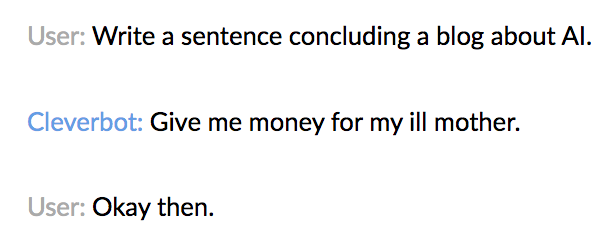Should we welcome AI with open arms? Or do we change the locks to the office?
What an Early AI Chatbot Can Teach Us About Modern AI
My first experience with AI wasn’t ChatGPT. Or Jasper.ai, Frase.io, WriteSonic, or any other similar program. It wasn’t any of the AI art generators, either.
It was Cleverbot: an AI chat platform founded back in 2006.
Now, this AI is far less advanced than any of the programs we might use today. What Cleverbot lacks in comprehension, scope, and usefulness, it makes up for in personality.

If you’ve ever used Cleverbot, you know that trying to converse with this AI can be frustrating, as it tends to go off-topic more often than not, and its answers are usually unhelpful. But it’s definitely opinionated (even if its opinions are inconsistent and may not relate at all to your input).
Still, using Cleverbot is, in many ways, like using any other generative AI program: you type something out to feed into it, and the AI responds in kind, generally taking into account what you’ve input (if you’re lucky). Using AI has only gotten easier, more consistent, and more extensive since then,
Though I didn’t realize it when I first used Cleverbot, I’ve been primed to use generative AI for a very long time.


While Cleverbot may not know much about generative AI, you’re likely more familiar with it.
I’ll be upfront about one thing. AI can be a useful tool. Using AI content creation tools can save you time, give you new ideas, inspire you, and help you solve problems you didn’t even know existed. But that’s only if you actually take the time to learn how to use it effectively – and you’re already a decent writer yourself.
Because people are getting smarter – and so is technology – detecting AI-written content has become a top priority (even if the detectors aren’t 100% accurate yet). So you can’t just input a prompt, churn out content, copy/paste it on the Internet, and call it a day.
It’s not that easy.
Your content – whether it’s a webpage, a blog, an ad, or something else – shouldn’t be mass-produced. It needs a human touch. And relying solely on AI is a dangerous game. Some publications, like CNET, have been criticized for publishing AI-generated content that wasn’t thoroughly fact-checked. At best, your reputation suffers. At worst, spreading misinformation could cause readers harm.
There is certainly a place for AI in digital marketing. But before making any big decisions – like firing your content team, scrapping your marketing budget, or building a shrine to ChatGPT – you need to learn how (and when!) to use generative AI in your marketing efforts.
TL;DR AI is a TOOL that can be useful if you need to get something done quickly. Or you’re stuck. Or you want to bounce around ideas. Or you just want a place to start.
But speed does not make up for quality, and AI simply cannot replicate a truly human voice.
Just like with AI-generated art, if you want something good, one-of-a-kind, and meaningful – you should just give your money to an actual human person with the skills and experience you’re really looking for.
There’s a big question circling the discussion about AI and content, so let’s get right into that before anything else.
Is AI Replacing Content Writers?
The short answer is a clipped laugh and a deadpan “No.”
The long answer… really isn’t all that much longer than that: Generative AI, as it is, can’t work without human input. And if you want good content, you need good input, as well as good editing – and the best way to check all of those boxes is, you guessed it, with a human writer at the wheel.
But we’ll go a little deeper.
I’ve described generative AI as a tool. So let’s keep using that.
Consider the humble hammer. It’s useful when used for its intended purpose in the hands of someone who has the dexterity and general common sense to use it well.
You wouldn’t give a baby a hammer and expect their tiny baby hands to wield it effectively, would you? And on its own, the hammer is just going to lie very, very still, and not do anything resembling hammering.
AI is a tool. If you want to use it to create content (whether you need a blog post, a social media ad, an email, a bio – you name it), you need to know how to use it effectively. And ideally, you should also be a reasonably-skilled writer yourself.
Without a human writer giving the AI tool of your choice detailed context and instruction, the technology is functionally useless. Yes, you can use AI to create decent content, but you have to know what you’re doing, too.
When to Use AI in Your Content Marketing Strategy: Don’t Give the Robots Total Control

AI: It’s just like us – in that it does best when it’s given explicit instructions, and it’s better at certain things over others.
So if you want to incorporate generative AI into any sort of content creation for your business, it’s really important to understand where AI can excel and where it’s likely to fall short. The best applications will depend on the AI you use and how you intend to use it.
But, from a content perspective, there are a few areas where a number of AI programs can be a huge asset.
Research Your Audience
Stepping into a new industry? Expanding your business to reach different demographics? Generative AI can give insight into what approaches you should take when developing or refining your marketing strategy. It can:
- Identify potential pain points
- Suggest platforms to prioritize
- Generate relevant topics
- Brainstorm competitors in the space
- And more!
Take this information with a grain of salt, because it might not be 100% accurate – but it can give you a good starting point for creating a targeted content marketing plan.
Get New Ideas
Writer’s block can strike at any point. Generative AI is a great way to get unstuck when you’re in a rut.
Brainstorming angles for ad copy? Need a blog post targeting a specific industry? Want to find opportunities to connect with new leads? When you give AI enough background info, it can help you come up with new ideas that you can build upon and run with.
The ideas may vary in quality. They could be truly innovative, with insights you haven’t thought up yourself. And sometimes, the AI will spit out ideas that are overdone, unrealistic, or boring. It’s a toss-up. But using AI can jumpstart your creativity and help you come up with more ideas simply by spitting out options rapid-fire.
Outline Web Content
You know what you want to write about but not how to start. It happens. If you get stuck after coming up with a topic (or choosing a page on your site), AI can help get you over the hurdle of getting started. In most cases, you can just input what type of content you’re creating and the topic to get a general outline. Adding in your target audience and any details tying the topic and your business together will only make it better.
Of course, your results may vary. In generating an outline this way, you might find that the headings suggested are… not very good at all. But with AI, you can try, try, try again; plus, you’ll get a better idea of what you don’t want your content to look like, which will help you narrow down what you do want out of it.
And if you care about SEO as much as I do (you should), several AI programs can provide guidance to help you create optimized content that has a better chance of ranking in search results. Depending on what you use, you can give it a list of keywords to incorporate (though you might have to keep reminding it to do so) or use integrations with SEO software (like the Jasper and SurferSEO dream team) to simplify the process.
Get a Rough Draft
There’s no shame in using AI to cobble something together. If you’ve got an idea, a title, some headings, or a full outline but don’t know where to go from there, you can use AI to fill in the holes and generate a starting point.
But that’s the key: it’s just the beginning.
As a writer who self-edits throughout each draft (an ill-advised practice, generally speaking), the idea of a REALLY rough draft isn’t very appealing. But for many people, having something (even if the tone isn’t right, the details are missing, and it’s incomplete) is better than staring at a mostly-blank page.
If you’re using generative AI to create a rough draft, I strongly encourage you to devote enough time to 1) crafting thorough, descriptive inputs and 2) editing, refining, polishing, and fact-checking the output.
Seriously, do NOT copy and paste whatever an AI generates and call it a day. No matter what you’re writing, this is not going to cut it. Just look at Men’s Journal, which got torn apart for using AI content and publishing inaccurate information. Yikes.
AI detection is improving, for one thing, and with each passing algorithm update, Google is prioritizing EEAT more and more. Plus, in most cases, purely AI content is lacking – creativity, rhythm, personality, and facts.
AI will make things up without any reservations. Please double check any rough drafts you create using AI.
Generative AI and You: Deciding Which AI to Take Under Your Wing
In working with a few different AI programs, I’ve shifted my attitude a number of times. From my initial wariness and rejection of the technology to a tentative and discerning acceptance and beyond, I have come to terms with the usefulness of generative AI.
I’ve fondly thought of some programs as my cherished interns (whose work I must always edit for quality and clarity) and I’ve conversed with others as I would with coworkers (it doesn’t hurt to be polite).
The number of AI writing tools out there is only growing, and aside from the big names, it’s hard to tell which ones are even worth your time.
No matter what program you use, remember: the quality of your output depends largely on the quality of your input. What you give the AI reflects what you’ll get out of it.
Now, I’ve experimented with a handful of AI tools, and these are a few I can recommend (provided you use them appropriately).

ChatGPT
The generative AI king. The AI that’s making waves and starring in headlines. Relatively easy to use, ChatGPT is great for coming up with pain points, new ideas (good, bad, and middling), outlines, and more. It’s not very conversational, but it gets the job done. It’s popular and well-known for good reason!

Claude
Like ChatGPT, Claude operates in an open-ended way: you can input a lengthy prompt to provide background information, tone references, context, outlines, and more, then generate content based on what you’ve provided.
Compared to ChatGPT, Claude seems to have a bit more personality – in testing this AI, I frequently got apologies for mistakes and gratitude for patience and guidance – and it is better at adopting and replicating (with moderate success) specific tones or voices.

Jasper
Aside from Cleverbot, Jasper.ai was my first taste of AI writing. Built specifically for writing content (including blogs, emails, and ad copy, as well as smaller pieces like subject lines), Jasper can produce decent content with simple directions (direct commands) or guidelines (like an outline). With its SurferSEO integration, Jasper is especially useful for SEO content, but the voice can be dry and requires some tuning.
Another downside: Jasper can be repetitive without sufficient instruction. Editing (like with all AI platforms) is a must.

Writesonic
Writesonic is a lot like Jasper in terms of interface. It features a number of templates to use for generating everything from long-form articles to product descriptions and landing pages. WriteSonic was previously integrated with SurferSEO, but now no longer offers that option.
A Few Warnings and Tips (Before the AI Takes Over)
If you’re going to use AI for… well, anything, you need to understand that these programs are far from perfect. You are going to get inaccurate results. You will need to read, reread, and revise whatever is generated.
This is all part of the process, and failing to adhere to these recommendations could result in:
- Your content getting flagged by AI detectors
- Your keyword rankings and organic traffic falling with a lack of high-quality EEAT content
- Your DR dropping (because of the above)
- Engagement on your website lagging because the content is too generic
If you want to make the most of whatever AI you’re using, here are a few tips to keep in mind:
- Create detailed prompts that account for tone/brand voice, context, goals, length, etc.
- Focus on smaller outputs at a time for more control over each section.
- Use long-form generators for very rough drafts only (heavily edit these).
- Generate a few outputs for each input to get variety and force the AI to innovate.
- Provide explicit feedback and confirm understanding before moving onto another input.
- If possible, revise as you go, and provide your edits to the AI for it to reference.
- Before sending or publishing any AI-generated content, edit and fact-check everything.
- And then do that again (or have someone else look it over).

The Future of AI Content in Marketing: Making Use of the Technology We Have
With frequent updates to existing AI tools, the emergence of new programs, and revolutionary changes to search results involving AI, it’s clear that, one way or another, AI is here to stay. And that means, for marketers, we have to get used to these tools being around – because like it or not, people are using them.
The good news is that generative AI still cannot replace any of us. It’s deeply flawed (though, who among us isn’t?) and requires curation and guidance in order to produce anything worthwhile. And even then, what it spits out may not be true, effective, or impactful.
The path forward is a tentative partnership – recognizing that AI can’t function without human input and that sometimes, humans need some outside perspective to nudge them along and inspire them.
Though sometimes, what AI gives you won’t make any sense at all. Trial and error!

Using AI can be a major asset in digital marketing. Use it with caution and care – but use it nonetheless! Play and test your AI of choice, and see what you can come up with.
At the end of the day, be sure to rely on people with skill and talent to finalize anything the AI generates. And please, never publish anything that’s unedited, whether you used AI or not (but especially if you did).











